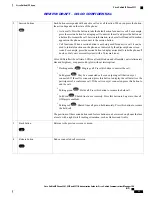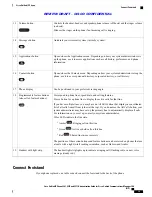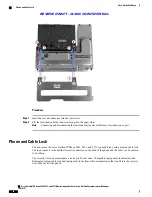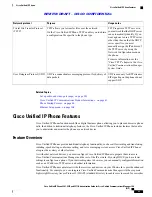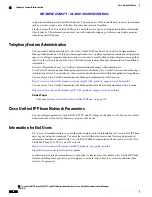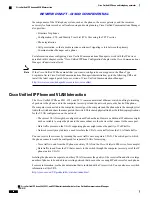
Reference
Topic
See
Cisco Unified Communications Manager Phone Addition Methods, on
page 50
.
Security and phone configuration files
See
IPv4 Setup Menu Options, on page 113
.
Changing the TFTP Server 1 or TFTP Server 2
option on the phone when security is implemented.
See
Security Setup Menu, on page 123
.
Items on the Security Setup menu that you access
from the phone
See
Control web page access, on page 249
.
Disabling access to the web pages for a phone
See
Cisco Unified IP Phone Security Problems, on page 273
and
Troubleshooting
Guide for Cisco Unified Communications Manager
.
Troubleshooting
See
Basic Reset, on page 290
.
Deleting the CTL file from the phone
See
Basic Reset, on page 290
.
Resetting or restoring the phone
See these sections:
•
802.1X Authentication, on page 33
•
Security Setup Menu, on page 123
•
Status Menu, on page 227
•
Cisco Unified IP Phone Security Problems, on page 273
802.1X authentication for Cisco Unified IP Phones
Supported security features
The following table provides an overview of the security features that the Cisco Unified IP Phone 8961, 9951,
and 9971 supports. For more information about these features, Cisco Unified Communications Manager, and
Cisco Unified IP Phone security, see
Cisco Unified Communications Manager Security Guide
.
For information about current security settings on a phone, press
and choose
Administrator Settings
>
Security Setup
.
Table 3: Overview of Security Features
Description
Feature
Signed binary files (with the extension .sbn) prevent tampering with the firmware image
before the image is loaded on a phone.
Tampering with the image causes a phone to fail the authentication process and reject the
new image.
Image authentication
Cisco Unified IP Phone 8961, 9951, and 9971 Administration Guide for Cisco Unified Communications Manager
10.0 (SIP)
28
Cisco Unified IP Phone
Supported security features
REVIEW DRAFT - CISCO CONFIDENTIAL




